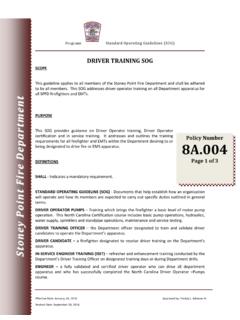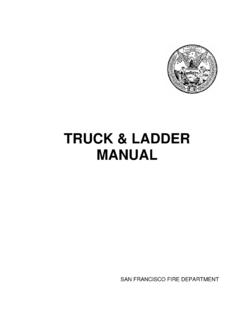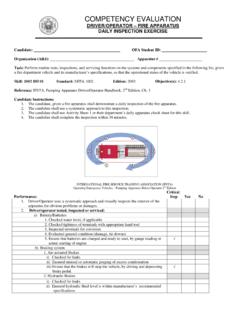Transcription of DRIVER/OPERATOR - AIRCRAFT RESCUE FIRE FIGHTING …
1 DRIVER/OPERATOR - AIRCRAFT RESCUE fire FIGHTINGNFPA 1002 The following detailed lesson plans for apparatus DRIVER/OPERATOR - AIRCRAFT RESCUE fire Fighter are based on NFPA 1002, Standard for fire Department Vehicle DRIVER/OPERATOR Professional, 1993 Edition. These lesson plans contain the same material that is covered in the Career Development Course for DRIVER/OPERATOR ARFF. The material in these lesson plans follows natural learning simple to complex sequencing practices. Therefore, mastery of the material in the beginning is required before advancing to the latter lesson plans. The sequence of material in these detailed lesson plans is different from the Career Development Course and NFPA 1002 sequence, which were designed to serve other purposes.
2 It is recommended that you become familiar with NFPA 1002, Standard for fire Department Vehicle DRIVER/OPERATOR Professional Qualifications prior using these lesson plans. The following list identifies all Lesson Plans and the related NFPA 1002 Job Performance Requirements. Note that if some of the numbers appear more than once; this is because several of the Job Performance Requirements or their prerequisites have to be broken in parts and taught at different times. Finally, if only the Job Performance Requirement number is identified, then all the prerequisite knowledge and skills are covered in that lesson. Lesson Plan Plan Plan Plan 47-2 Lesson Plan Plan 67-4 Lesson Plan DRIVER/OPERATOR - AIRCRAFT RESCUE fire Fighting1 Lesson Plan 1 DOD fire SERVICE CERTIFICATION SYSTEMLESSON PLAN 1 Personnel Classification: apparatus DRIVER/OPERATOR - AIRCRAFT RESCUE and fire FIGHTING ApparatusSubject:Preventive MaintenanceNFPA 1002 Materials/Equipment:ARFF vehicle, service records used by the agency, including fire apparatus history cardReferences:NFPA 1002: fire Vehicle operator Professional Qualifications, 1993 National fire Protection Association, Quincy, MassachusettsNFPA 414.
3 Standard for AIRCRAFT RESCUE and fire FIGHTING Vehicles, 1995 National fire Protection Association, Quincy, 1500: Standard on fire Department Occupational Safety and Health Programs. 1992 National fire Protection Association, Quincy, MassachusettsIFSTA, AIRCRAFT fire Protection and RESCUE Procedures, 2nd Edition, 1992, fire Protection Publications, Oklahoma State , fire Department Pumping apparatus , 7th Edition, 1989, fire Protection Publications, Oklahoma State , fire Stream Practices, 7th Edition, 1989, fire Protection Publications, Oklahoma State , Water Supplies for fire Protection, 4th Edition, 1988, fire Protection Publications, Oklahoma State Order.
4 AIRCRAFT Crash and Structural fire FIGHTING Truck ( P-19, P-19A, P-19B)(TO 36A12-8-17-1, TM 08674A-10/1, TM 5-2410-219-10, NAVFAC ), 16 June 1984, Departments of the Air Force, Army, and Navy, Washington, Navy AIRCRAFT Firefighting and RESCUE Manual (NAVAIR 00-80R-14).1 May 1988, Naval Air Technical Services, Philadelphia, Emergency RESCUE Information( fire Protection) 003-105E-915 May 1995 Warner Robins AFB, GAApparatus DRIVER/OPERATOR - AIRCRAFT RESCUE fire Fighting2 Lesson Plan 1 Additional Information:Applicable Technical ManualsIFSTA Pumping apparatus Series Videotapes, fire Protection Publications, Oklahoma State UniversityApparatus DRIVER/OPERATOR - AIRCRAFT RESCUE fire Fighting3 Lesson Plan 1 Instructor Tasks Review lesson outline to ensure understanding of contents and procedures.
5 Review references for lesson. Use additional references and your knowledge to enrich lesson outline. Select and prepare any additional audio-visual aids that may assist in the presentation of the lesson. Ensure that all equipment needed, including any audio-visual equipment, is available. Review lesson at end of session to ensure student understanding. Ensure that the topics and objectives of the lesson have been adequately DRIVER/OPERATOR - AIRCRAFT RESCUE fire Fighting4 Lesson Plan 1 INTRODUCTION AND purpose of the relation to previous and following NFPA 1002 objectives for this any additional materials for this lessonPRESENTATIONLESSON OUTLINEINSTRUCTOR Tests, Inspections, and Servicing to an apparatus checkThe majority of the information presented here is by automotive system: battery, coolant system, electrical system, etc.
6 However, as ARFF Driver/Operators become more familiar with vehicle, it may be easier and quicker to approach the vehicle location by location: inside the cab, around the body, under the hood, check for corrosion around terminals and other areas surrounding the these clean to ensure maximum contact between battery and electrolyte the water level of the battery and fill, if fill point should at least cover sure water is between minimum andmaximum fill is the density of the water which tells thedriver/ operator how charged the battery check; draw water from battery into a hydrometerApparatus DRIVER/OPERATOR - AIRCRAFT RESCUE fire Fighting5 Lesson Plan 1 LESSON OUTLINEINSTRUCTOR the measurement on the hydrometer which indicates whether the battery is charged enough to must be done cell by for the voltmeter to the two terminals of the battery.
7 Be sure that the polarity is correct: red on red (positive) and black on black (negative) sure voltmeter is set to the appropriate the the battery if the hydrometer indicates the battery is polarity of battery to be charged (positive or negative ground) red charger cable to positive battery black charger cable to negative battery battery charger to a reliable power source (away from gasoline and other flammable vapors) desired battery charging voltage andcharging rate (if so equipped); switches on battery chargers should be in the OFF position when not in caution because hydrogen gas is producedduring procedure to disconnect the charger test by tapping the brake low air warning air chuck on rear of emergency brakes (hand brakes) for holdApparatus DRIVER/OPERATOR - AIRCRAFT RESCUE fire Fighting6 Lesson Plan 1 LESSON OUTLINEINSTRUCTOR coolant system protects both engine and safety, be sure coolant is checked when the engine is entirely the coolant color and level in the radiator and add fluid (if applicable) the hoses for cracks or the coolant system and add rust inhibitor (if applicable)
8 The radiator fan for loose or cracked temperature gage reading with engine are numerous electrical connections in an apparatus ; damage from moisture or corrosion can render an electrical connection headlight dimmer clearance, stop, and back up all compartment lights and warning lights and the floodlights and motor-driven equipment should be started and run once a rotating hose reel apparatus header and defroster heater and/or air conditioner (if applicable) public address system and audible and usual warning devicesApparatus DRIVER/OPERATOR - AIRCRAFT RESCUE fire Fighting7 Lesson Plan 1 LESSON OUTLINEINSTRUCTOR full tank of fuel.
9 Ensures maximum running fuel level, add fuel if fuel pumps and filters fuel tank cap vent for blockage, clearif moisture from fuel/water certain the fluid added is compatible with the fluid already in the reservoir; type of fluid needed is often printed on reservoir or check appropriate technical off lid of reservoir before opening to prevent contamination from water or other to be filled is also found in the appropriate technical master cylinder power steering fluid reservoir (if applicable) objective of good lubrication saves maintenance and repair dollars; reduces out-of-service gives protection against corrosion, foaming, sludging, and carbon protect oil from contamination, prevent any unnecessary engine startsApparatus DRIVER/OPERATOR - AIRCRAFT RESCUE fire Fighting8 Lesson Plan 1 LESSON OUTLINEINSTRUCTOR technical order for correct viscosity of the engine oil exterior of engine for transmission oil exterior of transmission for all oil lines for leaks, corrosion or differential oil oil pressure with engine tires for cuts, breaks.
10 And proper inflation and uneven valve stems for corrosion or tires to proper level as noted on lugs for tightness and rims for steering gear for excessive motion and periodically lubricate steering seals on steering fluid reservoir, add fluid if all lines and hoses for to make sure belts are belts for for proper tension , appliances, and , appliances, and equipment refer to those items carried on the fire apparatus but not permanently attached to or a part of the removable equipment is common to all fire equipment and should be checked dailyApparatus DRIVER/OPERATOR - AIRCRAFT RESCUE fire Fighting9 Lesson Plan 1 LESSON OUTLINEINSTRUCTOR and (if applicable)









